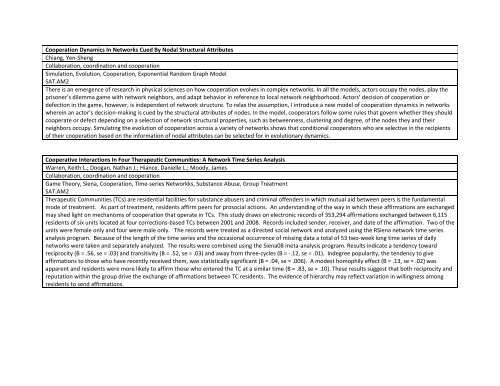Sunbelt XXXI International Network for Social Network ... - INSNA
Sunbelt XXXI International Network for Social Network ... - INSNA
Sunbelt XXXI International Network for Social Network ... - INSNA
You also want an ePaper? Increase the reach of your titles
YUMPU automatically turns print PDFs into web optimized ePapers that Google loves.
Cooperation Dynamics In <strong>Network</strong>s Cued By Nodal Structural AttributesChiang, Yen‐ShengCollaboration, coordination and cooperationSimulation, Evolution, Cooperation, Exponential Random Graph ModelSAT.AM2There is an emergence of research in physical sciences on how cooperation evolves in complex networks. In all the models, actors occupy the nodes, play theprisoner’s dilemma game with network neighbors, and adapt behavior in reference to local network neighborhood. Actors’ decision of cooperation ordefection in the game, however, is independent of network structure. To relax the assumption, I introduce a new model of cooperation dynamics in networkswherein an actor’s decision‐making is cued by the structural attributes of nodes. In the model, cooperators follow some rules that govern whether they shouldcooperate or defect depending on a selection of network structural properties, such as betweenness, clustering and degree, of the nodes they and theirneighbors occupy. Simulating the evolution of cooperation across a variety of networks shows that conditional cooperators who are selective in the recipientsof their cooperation based on the in<strong>for</strong>mation of nodal attributes can be selected <strong>for</strong> in evolutionary dynamics.Cooperative Interactions In Four Therapeutic Communities: A <strong>Network</strong> Time Series AnalysisWarren, Keith L.; Doogan, Nathan J.; Hiance, Danielle L.; Moody, JamesCollaboration, coordination and cooperationGame Theory, Siena, Cooperation, Time‐series <strong>Network</strong>ks, Substance Abuse, Group TreatmentSAT.AM2Therapeutic Communities (TCs) are residential facilities <strong>for</strong> substance abusers and criminal offenders in which mutual aid between peers is the fundamentalmode of treatment. As part of treatment, residents affirm peers <strong>for</strong> prosocial actions. An understanding of the way in which these affirmations are exchangedmay shed light on mechanisms of cooperation that operate in TCs. This study draws on electronic records of 353,294 affirmations exchanged between 6,115residents of six units located at four corrections‐based TCs between 2001 and 2008. Records included sender, receiver, and date of the affirmation. Two of theunits were female only and four were male only. The records were treated as a directed social network and analyzed using the RSiena network time seriesanalysis program. Because of the length of the time series and the occasional occurrence of missing data a total of 53 two‐week long time series of dailynetworks were taken and separately analyzed. The results were combined using the Siena08 meta‐analysis program. Results indicate a tendency towardreciprocity (B = .56, se = .03) and transitivity (B = .52, se = .03) and away from three‐cycles (B = ‐.12, se = .01). Indegree popularity, the tendency to giveaffirmations to those who have recently received them, was statistically significant (B = .04, se = .006). A modest homophily effect (B = .13, se = .02) wasapparent and residents were more likely to affirm those who entered the TC at a similar time (B = .83, se = .10). These results suggest that both reciprocity andreputation within the group drive the exchange of affirmations between TC residents. The evidence of hierarchy may reflect variation in willingness amongresidents to send affirmations.
















